This study describes curious cases of “missing” information about petroglyphs reported (and recorded?) at the archaeological complex at Beringa in the Majes Valley of southern Peru. It was claimed (2007) by the leading excavator, Prof. Tiffiny Tung, that all petroglyphs were documented in 2001 and yet not a single illustration / description of the Beringa petroglyphs is available. This study tries to answer that inconsistency. Updated September 2023.
By Maarten van Hoek
*
*
The Mislaid Beringa Petroglyph
A Missed Opportunity or a Misleading Missive?
*
Updated revision: September 2023
Maarten van Hoek
*
Introduction
Beringa is the name of an important archaeological complex in the Majes Valley of southern Peru. The ruins of the extensive village settlement at Beringa (with both domestic and mortuary contexts) are located on a low, flat-topped ridge parallel to and immediately overlooking the River Majes to the west. The site was at least occupied in the first part of the Middle Horizon (ca. A.D. 600 to 800) and again in the initial phase of the Late Intermediate Period (ca. A.D. 1050 to 1150) and analysis of excavated remains suggest that Beringa was home to fisher folk, agriculturalists, and textile weavers, essentially comprising a community of commoners (Tung 2007a: 943 – 944). Although Tung primarily suggests that the location had much to do with being easily defensible (2007a: 952), in my opinion also other factors may explain the elevated location, such as the advantage of being protected against intermittent flooding of the Majes Valley. In this paper I leave aside the – only in this context – irrelevant role of the Wari, who visited (occupied?) the Majes Valley, as well as Beringa. Also the question who or what caused the many signs of violence to human skulls excavated at Beringa will be ignored here. This study focusses on only one purportedly important aspect: rock art at Beringa.
*
Rock Art at Beringa
The archaeological site of Beringa was scientifically investigated and excavated by a team of academic researchers in 2001, supervised by Prof. Tung. The results were published in Andean Past (Tung 2007b), which – in my opinion – involved a very important discovery concerning rock art reported at Beringa. This possibly important, yet probably undervalued discovery was – in my opinion inadequately – described by Tung who wrote that in Unit 2 of Sector A at Beringa a petroglyph of a camelid – executed on the internal surface of a foundation stone – had been excavated. The team also recorded petroglyphs on boulders near the site of Beringa (Tung 2007b: 258). Although no further information or illustrative illustrations of the “camelid” petroglyph were included in her paper, I regard this complex of rock art to be of importance, especially within the context of the rock art of the Majes Valley. However, in my opinion this important discovery seems to have been neglected by Tung in her paper, as I will explain.
Importantly, Tung argues that the “camelid” petroglyph discovered inside Unit 2 – Sector A supports the notion that this building had a ritual function. She thus overlooked the possibility that the (much older?) petroglyph-stone may have been used simply as building material, like with the Warango church at Toro Grande immediately east of the enormous boulder field of Toro Muerto, which is also said to incorporate petroglyph stones (Linares Málaga 2011: 206). If indeed the stone is an example of re-use of building material, the “ritual” function of the room may well be erroneous in this respect. If not an example of re-use, the ritual character is – in my opinion – not even established with certainty.
It is moreover remarkable that, although – especially because of the rich rock art repertoire especially at the rock art sites of Toro Muerto and Alto de Pitis, the Majes Valley truly deserves the title “the Death Valley of the Andes” (Van Hoek 2013) – none of the published works about Beringa (available to me) offers any link with the rich rock art gamut of the Majes Valley, while the presence of at least the Toro Muerto petroglyphs certainly will have been known to many of the researchers digging at Beringa. Only the paper by Tung (2007b: 258) mentions the presence of petroglyph boulders at Beringa, without, unfortunately, offering any further information or illustrations, and, more importantly, also not offering the possibility to establish any relationship with the rich repertoire of the important neighbouring rock art sites in the Majes Valley and beyond.
Of course I was curious to learn more about the Beringa petroglyphs and thus I emailed Tung, but unfortunately she was not able to help me by providing me with any additional information about the style and content of the rock art at Beringa. She emailed me that she did not have any photos of the petroglyphs at Beringa; not even of the “camelid” petroglyph, because that was not her primary subject of exploration (Tung, July 2012: pers. comm.). To me this sounds very strange, because in her paper she writes that many photos had been taken during excavation (Tung 2007b: 269). Why not photographing such an important find? Did she not realise how crucial this petroglyph was? An archaeologist working in the Majes Valley – housing one of the biggest rock art concentrations in the world – should have been aware in advance of the importance of rock art in general, and of the Beringa “camelid” petroglyph in particular.
What makes the lack of any illustration of the Beringa petroglyphs even more hard to believe, is the fact that she wrote in her paper that the mapping team documented all visible architectural features, including petroglyphs (Tung 2007b: 269). When I informed Tung (in 2012) about this inconsistency, she abruptly ended our constructive email-communication. Having said all this, I now wonder why no illustrations of the Beringa petroglyphs are available. Has it anything to do with silencing a rock art researcher, only because he spotted an inconsistency?
Consequently I asked Augusto Cardona Rosas, an archaeologist deeply interested in Arequipa rock art and director of CIARQ, Arequipa, who visited the Beringa Project, and Bruce Owen of the Department of Anthropology, Sonoma State University, USA, who functioned as the project-ceramicist during a large part of the excavations, if they had taken any photographs of the petroglyphs. Via email they both answered me that they as well did not have any photographs of the petroglyphs at Beringa (2012: pers. comm.).
To me it sounds very hard to believe that a scientific, archaeological survey would not ([photo]graphically) record all items related to the investigations; thus also not all rock art manifestations. Why only illustrating and fully describing ‘placas pintadas’ [Tung 2007b: Fig 9] and not the petroglyphs? In this study I argue that a full record of the “camelid” petroglyph (said to have been discovered in Unit 2 – Sector A) would have been of crucial importance in understanding Majes rock art in general (sensu stricto and sensu lato).
*
The Silenced “Camelid”
Why now is the rock art content of Beringa so important? First of all, earlier in this study I argued that the stone with the “camelid” petroglyph may well have been re-used (see also Van Hoek 2013: 96 – 99, and a full discussion in Van Hoek 2011). This would mean that the stone was decorated at a spot outside Sector A (but where?) and was – (much?) later – moved to Unit 2 in Sector A. This possibility should have been scientifically checked during the excavations supervised by Tung, but there is no mention of this possibility in her paper.
Even more importantly, especially when not re-used, a more proper survey of this (in situ!) stone in its original position should have been undertaken. It is even possible that the petroglyph was manufactured when the stone was already incorporated into the structure. Whatever the sequence, the investigation of the undisturbed (?) deposits covering the stone may have yielded much reliable, sealed-context information that would have been most useful – for instance – in a relative dating of this petroglyph. Especially pollen-analyses and dating of charcoal or other organic remains possibly present in the covering deposits may have yielded useful information, possibly leading to a more accurate dating of the petroglyph.
Figure 1: Large, fully pecked “camelid” (“ ” explained in Van Hoek 2023) petroglyph at Toro Muerto. Photograph © by Maarten van Hoek.
Click any illustration to see an enlargement and open the enlargement in a new window to see a much better version.
Furthermore, the labelling of the zoomorph by Tung as a “camelid” is meaningless without offering a good drawing or photograph. Even after twenty years of experience in the field and intensively studying rock art from the Majes Valley at home, I am still uncertain in several cases if indeed a Majes petroglyph of a quadruped depicts a camelid. To complicate things further, I am convinced that several petroglyphs of “camelids” in the Majes Valley show (added?) characteristics of other quadruped species, like the long tail or the claws of the feline (see for instance Figure 1 on previous page). For that reason I now prefer to use the general term “quadrupeds”, or to write “camelids” to express uncertainty (see also Van Hoek 2023). Tung however speaks of a camelid, without any reservation and without providing an illustration. Therefore, many questions remain, which will never be answered without a reliable illustration of the “camelid” on the slab of stone in Unit 2 – Sector A at Beringa. And there are many questions indeed.
First of all, it is important – when asking those questions – to realise that the rock art repertoire of the Majes Valley offers an enormous variation of camelid and purported “camelid” images that were created during a very long time span. They range from very large and much elaborated, outlined examples (earlier?) to very small and very simple match-stick depictions (later?), apparently of different ages. Let me review which questions I think a dedicated rock art researcher would be asking himself or herself.
Assuming that there was indeed only one image on the stone in Unit 2 – Sector A at Beringa, (and even that is not certain) what was the size of the petroglyph? But also, what was the size and shape of the stone? Was it worked on? Was the carved surface smooth or rough? At Toro Muerto I recorded petroglyphs of match-stick camelids measuring (nose to tail) 6 and 4 cm in length (Figure 2), while at La Laja I recorded some large, fully (yet very lightly and not outlined) pecked examples, one even measuring 78 cm across (Van Hoek 2022a). At Quilcapampa in the Sihuas Valley a petroglyph of an (almost) life-size “camelid” has been recorded by Stephen Berquist (Van Hoek 2021b: Fig. 64). On Boulder PAJ-028 at Illomas in the Manga drainage, a petroglyph of an outlined, decorated quadruped (most likely a camelid), measuring no less than (approximately) 230 cm in length has been recorded by Grupo Andaray from Arequipa (Jennings, Van Hoek et al. 2019: Fig. 19). It seems that size does (not) matter.
Figure 2: Match-stick petroglyphs of probable camelids, measuring 6 (left) and 4 cm across. Toro Muerto. Photograph © by Maarten van Hoek.
Then, what was the exact position of the petroglyph on the stone in Unit 2 – Sector A at Beringa? Was it placed in the centre or peripherical? Was the petroglyph broken-off, if placed near an edge? Was the animal oriented horizontally or diagonally (or perhaps vertically)? Was the head oriented to the left or to the right? Was it looking backwards or not? Were the feet present, and if so, were the feet all pointing in the same direction (usually they are pointing forward), or were there anomalies in this respect? Did the “camelid” have two legs or four legs? If the legs showed feet, were the hooves indicated or not? The two hooves are a positive indication to establish that a quadruped is a camelid (Figure 3), although even then the image may still show properties of the feline (like a long upcurved tail; see Van Hoek 2023). Did the animal have a leash attached to its neck, like some rare examples recorded at Toro Muerto (Figure 4), and at Quilcapampa in the Sihuas Valley (Van Hoek 2021b: Fig. 20), as well as at Illomas in the Manga drainage (Jennings, Van Hoek et al. 2019: Fig. 17B)?
Figure 3: Partially outlined petroglyph of a camelid. Note the two hooves projecting from its fully pecked hind leg. Toro Muerto. Photograph © by Maarten van Hoek.
Concerning the technique with which it was made. Was the petroglyph, incised, (re-)scratched, (lightly or crudely) pecked or abraded? Finally, were parts of the image intentionally obliterated, like with a petroglyph at Toro Muerto (Figure 5); a prehistoric practice explained by me earlier (Van Hoek 2005)?
Then there are questions about the layout. Was it a match-stick figure (see Figure 2)? If not, was it outlined or was it partially (see Figure 3) or fully pecked (see Figure 4)? If outlined, was the image empty or filled with (abstract) decoration (like lines, dots etc. see Figure 5)? Was it drawn with dots only, thus without a continuous line outlining the body (a technique occurring in Majes rock art, yet only very rarely)?
Figure 4: Fully pecked petroglyphs of a camelid “family”. Note the leash held by the anthropomorphic figure. Toro Muerto. Photograph © by Maarten van Hoek.
Figure 5: Outlined, yet later (ritually?) obliterated petroglyph of a camelid. Toro Muerto. Photograph © by Maarten van Hoek.
Was the slab with the Beringa “camelid” fully unearthed by Tung or not? This is relevant, as is demonstrated by a photo of a boulder at Toro Muerto by Núñez Jiménez (1986: Fig. 2318) showing a petroglyph that was interpreted by him as a bird (1986: Fig. 2317). In 2015 the PTM-team further excavated the bottom part of this boulder and revealed that the image had in fact two long legs that ended in the very distinct hooves of a camelid. Additionally, it is possible that – after having been (fully?) exposed by Team Tung – the Beringa “camelid” showed differences in patination (in case of having been partially buried at the original location and thus before having been incorporated in the later, anthropic structure). In rare cases a combination of style and patination provides certainty about relative dating, like the much less patinated, later petroglyphs of camelids with their young at Toro Muerto (Figure 6).
Figure 6: Match-stick petroglyphs of camelids. Note the difference in patination in Majes “Dancer” petroglyphs. Toro Muerto. Photograph © by Maarten van Hoek.
Finally, in some very exceptional cases it is obvious that either a male camelid or a female camelid has been depicted in the rock art of the Majes Valley (see Figures 4 and 6). Sex can be determined for instance when zoomorphic petroglyphs feature a phallus or a vulva, or – only regarding camelid images! – when having a smaller camelid (a young) in the suckling position between the legs (see Figures 4 and 6). Another obvious indication of sex are the rare but informative examples of copulation in Majes Valley rock art showing – in at least one case – the phallus and the apparent vulva (Figure 7). Did the Beringa “camelid” show any information about its sex? Without reliable illustrations we will never get the answers.
Figure 7: Petroglyphs of copulating camelids. The phallus and the possible vulva (the bulbous area at the back end – which is not a tail!) are discernible. Toro Muerto. Photograph © by Maarten van Hoek.
Finally, the possible “silencing” of the Beringa “camelid” strongly contrasts with the very detailed and illustrated discussion about the 224 placas pintadas discovered at Beringa (Tung 2007b: 261 – 262; Fig. 9). This is another inconsistency. Why? Because placas pintadas comprise – but only when applied onto natural pebbles (not onto anthropically fabricated clay tablets) – a most distinct form of Arequipa rock art. And yet Tung informed me that she did not make photos of the Beringa petroglyphs, because rock art was not her primary area of research (Tung, July 2012: pers. comm.). Obviously she thus contradicts herself by discussing and illustrating the placas pintadas at Beringa, but not the petroglyphs. It seems that Prof. Tung, working in the valley – housing the largest concentration of rock art in South America – was not aware of the importance of petroglyphs. Either she was not involved (as she claims herself), or perhaps the Beringa “camelid” petroglyph never existed.
*
More “Silenced” Petroglyphs
The same lack of illustrative material and information inhibits a proper analysis of the other rock art purportedly recorded at Beringa by Tung. Regarding the petroglyph boulders surrounding the site, it is most relevant to know whether the petroglyphs on those boulders showed only petroglyphs of camelids, or a mixture of all sorts of images of possibly different dates (and if so, which images; see for instance Van Hoek 2018: Fig. 94). In this respect I also refer to my publication about the rock art of Miraflores in the Manga Valley (25 km due west of Beringa), where – except for two felines – all biomorphic petroglyphs concerned simple match-stick camelids, which is rather unusual, yet perfectly reasonable within the context of the location of the art, as has been fully explained by me (Van Hoek 2022b).
Indeed, also the images on the boulders surrounding Beringa may well have been important. They may establish a possible relationship with the Unit 2 “camelid” and the whole Beringa Archaeological Complex, because those boulders may also have images of “camelids” similar to the example in Unit 2 – Sector A, or, if not related, they may have been revealing in the context of the general rock art repertoire of the Majes Valley (and the area beyond). Because Tung did not include (or did not have) any illustration of the imagery on the boulders surrounding the site, establishing a link between the “camelid” of Unit 2 in Sector A and the imagery on those boulders surrounding the site is also impossible. Another missed opportunity.
Unfortunately, none of the site maps (Tung 2007b: Figs 5 and 6) offers the locations of those boulders surrounding the site (there is also no mention of the numbers of boulders or of the images), so the term “surrounding” is vague. Their positions could have easily been indicated on a map. Moreover, also the location of the boulder bearing the “camelid” petroglyph has not been indicated on a map, not even on her detail-map of Units 2 and 3 (Tung 2007b: Fig. 10). Therefore, if indeed incorporated on purpose, with the goal to enhance the purported ritual character (as suggested by Tung), the possibly important orientation (sunrise – sunset, or even upwards) is unknown. I for one doubt the ritual character of the “camelid” petroglyph (and this also goes for the whole of Unit 2 and 3 – Sector A, as both rooms are said to have no tombs, only looter-pits). Finally, it seems that the excavations supervised by Tung did not even unearth the whole of Unit 2 and 3 and neither all units of the whole complex (Tung 2007b: Figs 5, 6 and 10). Her remark that no petroglyphs were observed in other structures (Tung 2007b: 258) is therefore questionable, as she thus seems to suggest that all structures had been excavated, which is not the case. More petroglyphs may therefore await being revealed.
I consider the unscientific lack of any description and illustration of the Beringa petroglyphs as a missed opportunity to better understand the mechanisms related to rock art production and image selection in this extremely important Andean rock art region. The absence of any detailed information about the Beringa petroglyphs in the paper by Tung proves again that – also in general – rock art is (too) often neglected in archaeology. It also proves that, unfortunately, professional academic researchers do not always (photographically) record everything relevant. I therefore recommend that every official, scientific archaeological survey/excavation records rock art – no matter how simple – in every possible way (photographically, textually and with maps). I also strongly advocate – when publishing about rock art as a researcher who is unfamiliar with (the regional) rock art (like Tung and Scaffidi) – to first consult an expert in regional rock art traditions (whether an academic or a non-academic!), before jumping to (often incorrect) conclusions and before publishing incorrect (graphical) material.
Based on the information that I now have available, it seems as if the Beringa “camelid” petroglyph was “silenced”. There are no drawings or photographs (made or available), despite the fact that Tung in her paper (2007b) claims that all petroglyphs were photographed during the excavation. Those pictures either were never made, or have been deleted, or I have been denied to receive copies for some unknown reason. I therefore wonder: did Tung actually record a petroglyph in Unit 2 – Sector A, or – for that matter – anywhere-else at Beringa? Were those important petroglyphs fictional or silenced?
Regarding the petroglyph(s) “recorded” at Beringa, the paper by Tung either proves to be a misleading missive, or the petroglyph in Unit 2 seems to have been mislaid. In other words, the petroglyph in Unit 2 may even never have existed. This seems to be confirmed by more recent publication focussing on camelid husbandry in the Majes and Sihuas Valleys (Alaica et al. 2022; Tung being a co-author). This more recent paper also briefly describes Beringa, referring to the paper by Tung (2007b). Importantly, the paper by Alaica et al. focusses on camelids. Then – in my opinion – a remarkable void regarding the description of the Beringa site emerges (Alaica et al. 2022: 4), as the possibly most important “camelid” petroglyph in Unit 2 – Sector A at Beringa is not mentioned at all. As far as I know the “camelid” in Unit 2 – Sector A at Beringa represents the – so far – (only?) example in the Majes Valley excavated in situ, moreover in a possibly sealed context. For that reason the “camelid” petroglyph in Unit 2 in Sector A at Beringa should have been treated with meticulous scientific attention during the excavation and – later – Beringa rock art should have been fully discussed in a publication together with many illustrations. All this did not happen.
Concluding, either the remark by Tung about not having photos of the Beringa petroglyphs (Tung 2012: pers. comm.) is questionable, or her report about Beringa (Tung 2007b) is questionable when it comes to information about rock art. As skilled bio-archaeologists Tung and Scaffidi published much most reliable and useful information about Majes prehistory. However, their remarks and illustrations regarding Majes rock art (and conclusions based on their rock art interpretations) are often questionable (Van Hoek 2021a) and even incorrect in at least two cases. In 2020 Scaffidi and Tung published illustrations of two rock art panels from the Majes Valley (one shown in Figure 8B) that I demonstrated to be demonstrably incorrect (Van Hoek 2020). In my opinion academics should only work with and publish correct information based on facts and facts only.
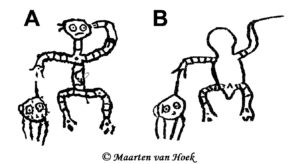 Figure 8: A: My 2010-drawing of a petroglyph at Toro Muerto; B: the incorrect illustration of the same petroglyph published by Tung and Scaffidi (based on 2020: Fig. 3a). Drawings © by Maarten van Hoek. Academic archaeologist Justin Jennings confirmed in an email to me that the two 2020-illustrations by Tung and Scaffidi (Fig. 3) are incorrect.
Figure 8: A: My 2010-drawing of a petroglyph at Toro Muerto; B: the incorrect illustration of the same petroglyph published by Tung and Scaffidi (based on 2020: Fig. 3a). Drawings © by Maarten van Hoek. Academic archaeologist Justin Jennings confirmed in an email to me that the two 2020-illustrations by Tung and Scaffidi (Fig. 3) are incorrect.
Compare the incorrect illustration by Scaffidi and Tung (orange inset in the photo below; original available here: Fig. 3) with the photograph that I made of the Toro Muerto petroglyph. The question-marks in the inset mark the discrepancies and prove that there is no weapon or object held by this figure and – moreover – that the layout is completely different. The illustration by Scaffidi and Tung is demonstrably incorrect (click to enlarge the photo and open the enlargement in a new window to see a much better version).
Finally, there seems to be a link between the Beringa Issues and the publication of those incorrect illustrations of the two Majes petroglyphs. In 2012 I asked Tung if she could send me photos of Beringa rock art. She answered that there were no photos made of the petroglyphs. To me this proves that either Tung’s answer was questionable, or that her paper is offering questionable information. There is no other explanation. What is now the link between her 2007b-Beringa paper and my 2020-Majes paper?
In 2012 Tung confirmed to me that there were no photos of the Beringa petroglyphs. The link is now that during my 15-months struggle involving the 2020-Majes paper by Tung and Scaffidi, I repeatedly asked the authors and the editor and other people for the full-size, unaltered, original photos of the two incorrect illustrations of the Majes rock art panels (Scaffidi and Tung 2020: Fig. 3). However, I never received any original, unaltered photo. Only two irrelevant photographs were published in their “Erratum”, both altered with D-Stretch (which were the same as two hardly legible photos published by Scaffidi et al. [2021 Fig. 2]). It seems that Tung (and Scaffidi and the Editor) do not want any original photo to be shared with me. Thus, not only are the photos of the Beringa petroglyphs and the originals of the Majes petroglyphs being silenced, also I am being silenced as a rock art researcher. When the original Majes photos would be provided, which is highly desirable in cases like this, then the inconvenient truth about the incorrect 2020-illustrations published by Tung and Scaffidi would be evident!
Figure 9: Outlined and decorated petroglyph of a camelid. Toro Muerto. Possibly its tail has been extended (to look like a feline-tail?). This is a close-up photo of the petroglyph that is also illustrated on the cover photo. Both photographs are © by Maarten van Hoek.
Note: All photos in this study have been digitally enhanced (not falsified) by the author.
*
References
Although I have taken every care to correctly include all the publications (and the relevant URLs) to which I refer to in this study, it is always possible that (hopefully minor) imperfections still have been made by me or that omissions occur. Moreover, due to certain circumstances I had to delete and/or update some of my publications, some of which are being referred to in this study. I apologise for any inconvenience, if any of the URLs does not work (anymore). You may contact me, as I may be able to provide you with the information you may need.
Alaica, A. K., B. K. Scaffidi, L. M. González La Rosa, J. Jennings, K. J. Knudson and T. A. Tung. 2022. Flexible agropastoral strategies during the 1st millennium CE in southern Peru: Examining yunga Arequipa camelid husbandry practices during Wari expansion through stable isotope analysis (δ13C and δ15N) in the Majes and Sihuas Valleys. Quaternary International. Pp. 1 – 17.
Jennings, J., M. van Hoek, W. Yépez Álvarez, S. Bautista, R. A. San Miguel Fernández and G. Spence-Morrow. 2019. Illomas: the three thousand year history of a rock art site in Southern Peru. Ñawpa Pacha, Journal of Andean Archaeology. Vol. 39-2; pp. 1 – 31.
Scaffidi, B. K., G. D. Kamenov, A. E. Sharpe and J. Krigbaum. 2021 (online version). Non-Local Enemies or Local Subjects of Violence?: Using Strontium (87Sr/86Sr) and Lead (206Pb/204Pb, 207Pb/204Pb, 208Pb/204Pb) Isobiographies to Reconstruct Geographic Origins and Early Childhood Mobility of Decapitated Male Heads from the Majes Valley, Peru. Journal of Archaeological Method and Theory.
Scaffidi, B. and T. Tung. 2022. Erratum to “Endemic violence in a pre-Hispanic Andean community: A bioarchaeological study of cranial trauma from the Majes Valley, Peru”.
Tung, T. A. 2007a. Trauma and violence in the Wari Empire of the Peruvian Andes: warfare, raids, and ritual fights. American Journal of Physical Anthropology. Vol. 133; pp. 941 – 956.
Tung, T. A. 2007b. The village of Beringa at the periphery of the Wari Empire: a site overview and new radiocarbon dates. Andean Past. Vol. 8; pp 253 – 286.
Van Hoek, M. 2005. Toro Muerto, Peru: Possible Prehistoric Deletion of Petroglyph Details. Adoranten – the Journal of The Scandinavian Prehistoric Society. Vol. 2005; pp. 73 – 80. Underslös, Sweden. Spanish version available at Rupestreweb.
Van Hoek, M. 2011. Aldea de Ramaditas, Chile: Architectural Art or Rock Art? In: Rupestreweb.
Van Hoek, M. 2013. The Carcancha and the Apu – Rock art of the ‘Death Valley of the Andes’. Book only available as PDF at ResearchGate.
Van Hoek, M. 2018. Formative Period Rock Art in Arequipa, Peru. An up-dated analysis of the rock art from Caravelí to Vítor. Book only available as PDF at ResearchGate.
Van Hoek, M. 2020. False Information Concerning Majes Rock Art, Peru. In: TRACCE – Online Rock Art Bulletin, Italy.
Van Hoek, M. 2021a. War and Weapons in Majes Style Rock Art? In: TRACCE – Online Rock Art Bulletin, Italy.
Van Hoek, M. 2021b. Accessing the Inaccessible. Rock Art of Quilcapampa, southern Peru. Oisterwijk, the Netherlands. Book only available as PDF at ResearchGate.
Van Hoek, M. 2022a. The Rock Art Site of La Laja – Majes Valley, Peru. In: TRACCE – Online Rock Art Bulletin, Italy.
Van Hoek, M. 2022b. The Petroglyphs of Cuesta de la Pachana and Miraflores, Manga Valley, Southern Peru. In: TRACCE – Online Rock Art Bulletin, Italy.
Van Hoek, M. 2023. The “Camelines” of Toro Muerto; Majes Valley, Peru. In: TRACCE – Online Rock Art Bulletin, Italy. Revised version.
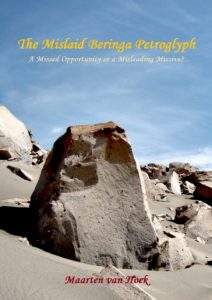
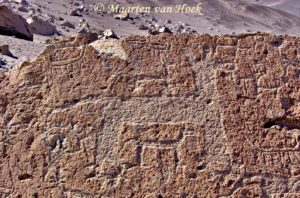

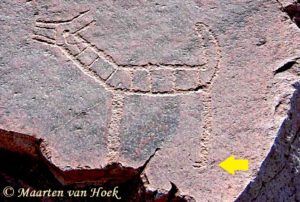
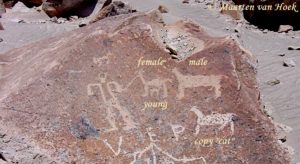
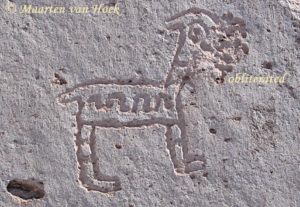
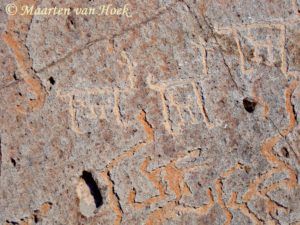
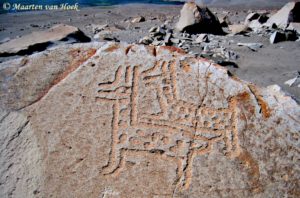
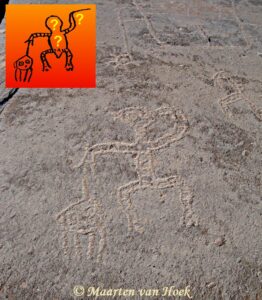
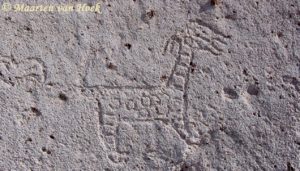
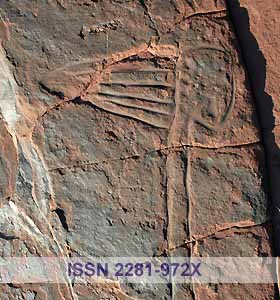













Leave a Reply